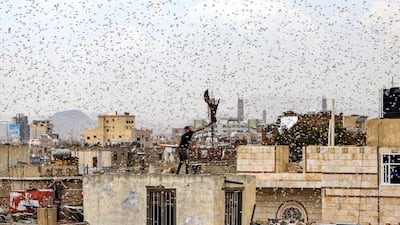Desert locusts have inundated Yemen’s rebel-held capital and surrounding regions this week, devastating farms but also providing a bumper crop of this Yemeni delicacy.
In the city of Sanaa, crowds of people chased the swarms of locusts using special nets. Children, adults and the elderly took to the streets, hunting the swarming locusts. Men stood on rooftops with large nets, scooping the insects out of the air.
This is the second major swarm to hit the Yemeni capital in recent weeks, with another passing through in June.
"Locusts are a nutritious source of food – they contain a great deal of vitamins and proteins," Amer Ahmed, a resident who took part in the locust hunt, told The National. "We hunt it and go back home to cook it with oil and eat it with rice and with bread. It is really delicious."
Residents of Sanaa told The National that traders had gathered around the public market to sell sacks of locusts. Traders said that a kilo of locusts cost only 700 Yemeni rial (Dh10).
Locals and traders said that locusts were a good remedy for numerous health problems, as well as being a good source of protein.
“We know from our fathers and grandfathers that locusts are used to treat various conditions such as diabetes,” one man in Sanaa central market told a local TV station.
But the locusts also cause devastation.
Farmers in the district of Hamdan, Khawlan and Bani Al Harith north of Sanaa said that the swarms had devoured their crops. The famed Yemeni grape farmers in the area who cultivate the country’s best vines said they had been particularly affected.
"Huge swarms attacked our farms, devouring every single green tree. All our crops were horribly damaged," one farmer from the Hamdan region told The National. "We stood helpless because we had nothing [we could do]... Alas, everything is gone."
An adult locust can eat its body weight in fresh vegetation every day and even a small swarm can consume enough food for 35,000 people in only 24 hours, according to the Food and Agriculture Organisation.
Once they swarm, they become highly mobile and are able to fly 150 kilometres in a day. With a female locust able to lay 300 eggs in her short life, a swarm can quickly grow to hundreds of millions of insectsand measure kilometres across. They can strip landscapes bare, cause hundreds of millions of dollars in damage and leave communities without food.
The UN's FAO, which runs the Desert Locust Information Service from its offices in Rome, said the war hampered efforts to control the swarm.
"Some ground control operations (500 hectares) are under way but their impact against the overall infestations may be limited because not all areas can be accessed and capacities are limited," the FAO said on July 16.
“Yemen is the most concerned and at highest risk because of widespread hopper band infestations that will cause swarms to form later this month, which could give rise to another generation of breeding by the end of August if conditions remain favourable.”
This year has seen several major swarms across the region after two cyclones in May and October last year brought heavy rains to a large area of Saudi Arabia's Empty Quarter, one of the main breeding grounds for locusts. Three generations of locusts were born in a short period of time before they were detected by ground monitoring teams, the FAO said.
Swarms have hit Yemen, Saudi Arabia, Iran, Jordan and Egypt and have even crossed to Sardinia in Italy.
Locusts breed and gather anywhere across millions of hectares of desert from Morocco to Pakistan. But areas along the Red Sea coast in Sudan, as well as Saudi Arabia’s Empty Quarter, are particularly fertile ground for locusts.
While usually solitary and small creature, when they start to gather they change to what scientists call a gregarious state. Not only do their behaviour change, but they physically transform as well. Changing colour, the locusts begin to move as a column in search of food.











